Birthstones
The Origin of BirthstonesThe history of birthstones involves the lives of many historical figures as precious stones are seen as signs of Power, Wealth, and Luxury. It’s uncertain how the specific months became connected with the various stones. However, some speculate that their origins date back to biblical times when the breastplate belonging to a priest was decorated with 12 assorted colored gems. The idea was proposed that each of the gemstones had special powers associated with the corresponding astrological sign, and that wearing these stones at the right time would have therapeutic or talismanic benefits. This started the tradition of wearing a colored stone each month as a sort of good luck charm. Initially people wore all twelve stones, rotating according to the month of the year to derive the greatest benefit of each stone. Believing that the various gems held magical powers for the individual born within a given month, people started to wear the stone associated with their birth month for the entire year. In 1912, the American National Association of Jewelers designed a list dedicating different gems to various months. What was once thought to be controversial based on its commercialism is now widely accepted as the official birthstone list. |
January Birthstone: Garnet
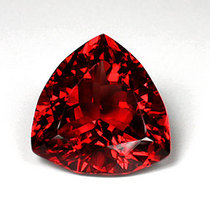 Garnet, the January birthstone, is named from the Latin word "granatus" meaning 'seedlike'. This stems from the fact that garnet crystals in their host rock appear in shape and color of pomegranate seeds. Although the color red is seen most frequently, there are many different colors and shades of Garnet. Garnets can also be found in colors such as green, yellow, and orange. Garnets were often used in the crowns of Kings and Queens, and a favored jewel of religious leaders. This gemstone was also believed to protect and preserve the honor and health of travelers. All of these powers of garnet were believed to be doubled for those born in the month of January.
Garnet, the January birthstone, is named from the Latin word "granatus" meaning 'seedlike'. This stems from the fact that garnet crystals in their host rock appear in shape and color of pomegranate seeds. Although the color red is seen most frequently, there are many different colors and shades of Garnet. Garnets can also be found in colors such as green, yellow, and orange. Garnets were often used in the crowns of Kings and Queens, and a favored jewel of religious leaders. This gemstone was also believed to protect and preserve the honor and health of travelers. All of these powers of garnet were believed to be doubled for those born in the month of January. February Birthstone: Amethyst
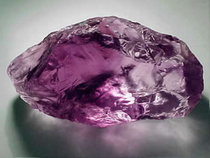 Amethyst is a member of the Quartz family which is the most common mineral on our planet. The most valuable member of this family, and birthstone for February, is the Amethyst gemstone. Since purple is considered a royal color, Amethyst enjoyed a historical importance as an insignia of power. The colors of Amethyst range from purple, violet, to pale reddish violet. Amethyst gets its name from the Greek work meaning "not to intoxicate". It is said that wearing amethyst, guards you against drunkenness and to instill a sober mind.
Amethyst is a member of the Quartz family which is the most common mineral on our planet. The most valuable member of this family, and birthstone for February, is the Amethyst gemstone. Since purple is considered a royal color, Amethyst enjoyed a historical importance as an insignia of power. The colors of Amethyst range from purple, violet, to pale reddish violet. Amethyst gets its name from the Greek work meaning "not to intoxicate". It is said that wearing amethyst, guards you against drunkenness and to instill a sober mind. March Birthstone: Aquamarine
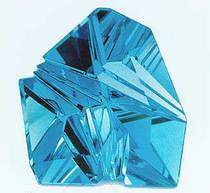 Aquamarine is the modern day March birthstone. Bloodstone is sometimes considered an alternate birthstone for March since it is the zodiac stone for Aries (Mar 21- Apr 20). Aquamarine is a variety of the Beryl family and ranges in color from almost colorless pale blue to green blue or teal. The name Aquamarine is derived from the Latin words meaning Water and Sea, and has a long tradition as the sailor's lucky stone. The Greeks and the Romans knew aquamarine as the sailor's gem, ensuring safe and prosperous passage across stormy seas. Legend has it that aquamarines were the prized possessions of mermaids and thus would protect sailors from danger, including warding off sea sickness.
Aquamarine is the modern day March birthstone. Bloodstone is sometimes considered an alternate birthstone for March since it is the zodiac stone for Aries (Mar 21- Apr 20). Aquamarine is a variety of the Beryl family and ranges in color from almost colorless pale blue to green blue or teal. The name Aquamarine is derived from the Latin words meaning Water and Sea, and has a long tradition as the sailor's lucky stone. The Greeks and the Romans knew aquamarine as the sailor's gem, ensuring safe and prosperous passage across stormy seas. Legend has it that aquamarines were the prized possessions of mermaids and thus would protect sailors from danger, including warding off sea sickness.April Birthstone: Diamond
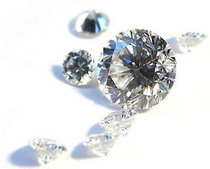 Diamond, the birthstone for the month of April, is the hardest natural substance known. It is also the anniversary gem for the 10th and 60th years of marriage. Since diamonds are composed of one single clement, they are the purest of all gemstones. Diamonds are traditionally linked to love, and both endure forever because of diamond's eternal strength. The name diamond is derived from the Greek adamas, which means invincible. Diamonds were discovered in India in 500 B.C. Today, the gem quality diamonds are used for fine jewelry and engagement rings. The industrial grade diamonds are used mainly for cutting and polishing. The formation of diamonds requires very high temperatures and pressure. The conditions occur in limited zones of the earth's mantle. Diamonds that have come to the earth's surface generally range from approximately 1 billion to 2.3 billion years old. (See Diamond Education for more information.)
Diamond, the birthstone for the month of April, is the hardest natural substance known. It is also the anniversary gem for the 10th and 60th years of marriage. Since diamonds are composed of one single clement, they are the purest of all gemstones. Diamonds are traditionally linked to love, and both endure forever because of diamond's eternal strength. The name diamond is derived from the Greek adamas, which means invincible. Diamonds were discovered in India in 500 B.C. Today, the gem quality diamonds are used for fine jewelry and engagement rings. The industrial grade diamonds are used mainly for cutting and polishing. The formation of diamonds requires very high temperatures and pressure. The conditions occur in limited zones of the earth's mantle. Diamonds that have come to the earth's surface generally range from approximately 1 billion to 2.3 billion years old. (See Diamond Education for more information.) May Birthstone: Emerald
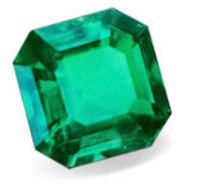 Emerald is among the most popular and most expensive of all gems. It is a variety of the Beryl Family. Emeralds intense green color has given this precious gem its important status throughout the centuries. The color of emerald is yellowish-Green to Green. The light green form of Beryl is not referred to as emerald, but rather green beryl. Emeralds are almost always some what flawed, or what Gemologists call 'Included'. These unique natural characteristics are usually other minerals trapped inside the Emerald. Emerald, a symbol of rebirth, is believed to grant the owner foresight, good fortune, and youth. It is also believed that emeralds will cure you of bad health, healing a variety of illnesses and insuring good health for the wearer.
Emerald is among the most popular and most expensive of all gems. It is a variety of the Beryl Family. Emeralds intense green color has given this precious gem its important status throughout the centuries. The color of emerald is yellowish-Green to Green. The light green form of Beryl is not referred to as emerald, but rather green beryl. Emeralds are almost always some what flawed, or what Gemologists call 'Included'. These unique natural characteristics are usually other minerals trapped inside the Emerald. Emerald, a symbol of rebirth, is believed to grant the owner foresight, good fortune, and youth. It is also believed that emeralds will cure you of bad health, healing a variety of illnesses and insuring good health for the wearer.June Birthstones: Pearl, Moonstone, and Alexandrite
PEARL
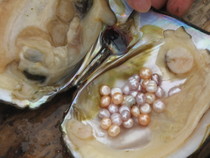 Pearls are unique as they are the only gem created by a living sea creature. They require no cutting, faceting, or polishing to reveal their natural beauty. Unlike all gems the pearl is an organic matter derived form oysters and mollusks. A natural pearl only occurs once in 15,000 mollusks. Due to this and the desire for pearls, highly skilled technicians began to put a nucleus or piece of mantle tissue into mollusks to help them produce a pearl. This process is called "culturing." In the early 1900s, the first successful commercial culturing of round saltwater pearls began. Since the 1920s, cultured pearls have almost completely replaced natural pearls in the market.
Pearls are unique as they are the only gem created by a living sea creature. They require no cutting, faceting, or polishing to reveal their natural beauty. Unlike all gems the pearl is an organic matter derived form oysters and mollusks. A natural pearl only occurs once in 15,000 mollusks. Due to this and the desire for pearls, highly skilled technicians began to put a nucleus or piece of mantle tissue into mollusks to help them produce a pearl. This process is called "culturing." In the early 1900s, the first successful commercial culturing of round saltwater pearls began. Since the 1920s, cultured pearls have almost completely replaced natural pearls in the market.
 Pearls are unique as they are the only gem created by a living sea creature. They require no cutting, faceting, or polishing to reveal their natural beauty. Unlike all gems the pearl is an organic matter derived form oysters and mollusks. A natural pearl only occurs once in 15,000 mollusks. Due to this and the desire for pearls, highly skilled technicians began to put a nucleus or piece of mantle tissue into mollusks to help them produce a pearl. This process is called "culturing." In the early 1900s, the first successful commercial culturing of round saltwater pearls began. Since the 1920s, cultured pearls have almost completely replaced natural pearls in the market.
Pearls are unique as they are the only gem created by a living sea creature. They require no cutting, faceting, or polishing to reveal their natural beauty. Unlike all gems the pearl is an organic matter derived form oysters and mollusks. A natural pearl only occurs once in 15,000 mollusks. Due to this and the desire for pearls, highly skilled technicians began to put a nucleus or piece of mantle tissue into mollusks to help them produce a pearl. This process is called "culturing." In the early 1900s, the first successful commercial culturing of round saltwater pearls began. Since the 1920s, cultured pearls have almost completely replaced natural pearls in the market.
MOONSTONE
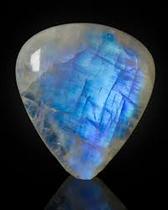 The third birthstone for June is the Moonstone. It was given its name by the Roman natural historian Pliny, who wrote that moonstone's appearance altered with the phases of the moon. Since earliest times, Moonstone has been a tangible connection to the magic of the moon - an amulet of protection for travelers, a gift of lovers for passion, a channel for prophecy, and a path to wisdom. Moonstone is a phenomenal gemstone that displays a floating play of light, called Adularescence. They are believed to encapsulate within the stone a spirit whose purpose is to bring good fortune. This gemstone is part of the family of minerals called Feldspar. Moonstone occurs in many igneous and metamorphic rocks and comes in a variety of colors such as green, blue, peach, and champagne. Moonstone has long been known for its calming, soothing qualities on the emotional body.
The third birthstone for June is the Moonstone. It was given its name by the Roman natural historian Pliny, who wrote that moonstone's appearance altered with the phases of the moon. Since earliest times, Moonstone has been a tangible connection to the magic of the moon - an amulet of protection for travelers, a gift of lovers for passion, a channel for prophecy, and a path to wisdom. Moonstone is a phenomenal gemstone that displays a floating play of light, called Adularescence. They are believed to encapsulate within the stone a spirit whose purpose is to bring good fortune. This gemstone is part of the family of minerals called Feldspar. Moonstone occurs in many igneous and metamorphic rocks and comes in a variety of colors such as green, blue, peach, and champagne. Moonstone has long been known for its calming, soothing qualities on the emotional body.
 The third birthstone for June is the Moonstone. It was given its name by the Roman natural historian Pliny, who wrote that moonstone's appearance altered with the phases of the moon. Since earliest times, Moonstone has been a tangible connection to the magic of the moon - an amulet of protection for travelers, a gift of lovers for passion, a channel for prophecy, and a path to wisdom. Moonstone is a phenomenal gemstone that displays a floating play of light, called Adularescence. They are believed to encapsulate within the stone a spirit whose purpose is to bring good fortune. This gemstone is part of the family of minerals called Feldspar. Moonstone occurs in many igneous and metamorphic rocks and comes in a variety of colors such as green, blue, peach, and champagne. Moonstone has long been known for its calming, soothing qualities on the emotional body.
The third birthstone for June is the Moonstone. It was given its name by the Roman natural historian Pliny, who wrote that moonstone's appearance altered with the phases of the moon. Since earliest times, Moonstone has been a tangible connection to the magic of the moon - an amulet of protection for travelers, a gift of lovers for passion, a channel for prophecy, and a path to wisdom. Moonstone is a phenomenal gemstone that displays a floating play of light, called Adularescence. They are believed to encapsulate within the stone a spirit whose purpose is to bring good fortune. This gemstone is part of the family of minerals called Feldspar. Moonstone occurs in many igneous and metamorphic rocks and comes in a variety of colors such as green, blue, peach, and champagne. Moonstone has long been known for its calming, soothing qualities on the emotional body.
ALEXANDRITE "Ruby by Day, Emerald by Night"
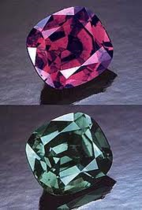 Another birthstone for June is a very rare phenomenal gem called Alexandrite. Alexandrite was first discovered in Russia in 1831 during the reign of its namesake, Czar Alexander II, and is an extremely rare chrysoberyl with chameleon-like qualities. The most sensational feature about this stone, however, is its surprising ability to change its color. Green or bluish-green in daylight, alexandrite turns a soft shade of red, purplish-red or raspberry red in incandescent light. This unique optical characteristic makes it one of the most valuable gemstones of all, especially in fine qualities. Since the discovery of alexandrite, the gemstone has been thought to bring luck, good fortune and love. It is also said to strengthen intuiion, creativity, and imagination. Alexandrite encourages romance. It is also said that through the stone, joy enters the lives of people with too much self-discipline. The stone reminds us of our purpose in life and our origin. It gives hope to those who are in despair about their lives. It brings strength and constantly reminds them of the light. With its changing color, it is a reminder that life is not only what it seems to be.
Another birthstone for June is a very rare phenomenal gem called Alexandrite. Alexandrite was first discovered in Russia in 1831 during the reign of its namesake, Czar Alexander II, and is an extremely rare chrysoberyl with chameleon-like qualities. The most sensational feature about this stone, however, is its surprising ability to change its color. Green or bluish-green in daylight, alexandrite turns a soft shade of red, purplish-red or raspberry red in incandescent light. This unique optical characteristic makes it one of the most valuable gemstones of all, especially in fine qualities. Since the discovery of alexandrite, the gemstone has been thought to bring luck, good fortune and love. It is also said to strengthen intuiion, creativity, and imagination. Alexandrite encourages romance. It is also said that through the stone, joy enters the lives of people with too much self-discipline. The stone reminds us of our purpose in life and our origin. It gives hope to those who are in despair about their lives. It brings strength and constantly reminds them of the light. With its changing color, it is a reminder that life is not only what it seems to be.
 Another birthstone for June is a very rare phenomenal gem called Alexandrite. Alexandrite was first discovered in Russia in 1831 during the reign of its namesake, Czar Alexander II, and is an extremely rare chrysoberyl with chameleon-like qualities. The most sensational feature about this stone, however, is its surprising ability to change its color. Green or bluish-green in daylight, alexandrite turns a soft shade of red, purplish-red or raspberry red in incandescent light. This unique optical characteristic makes it one of the most valuable gemstones of all, especially in fine qualities. Since the discovery of alexandrite, the gemstone has been thought to bring luck, good fortune and love. It is also said to strengthen intuiion, creativity, and imagination. Alexandrite encourages romance. It is also said that through the stone, joy enters the lives of people with too much self-discipline. The stone reminds us of our purpose in life and our origin. It gives hope to those who are in despair about their lives. It brings strength and constantly reminds them of the light. With its changing color, it is a reminder that life is not only what it seems to be.
Another birthstone for June is a very rare phenomenal gem called Alexandrite. Alexandrite was first discovered in Russia in 1831 during the reign of its namesake, Czar Alexander II, and is an extremely rare chrysoberyl with chameleon-like qualities. The most sensational feature about this stone, however, is its surprising ability to change its color. Green or bluish-green in daylight, alexandrite turns a soft shade of red, purplish-red or raspberry red in incandescent light. This unique optical characteristic makes it one of the most valuable gemstones of all, especially in fine qualities. Since the discovery of alexandrite, the gemstone has been thought to bring luck, good fortune and love. It is also said to strengthen intuiion, creativity, and imagination. Alexandrite encourages romance. It is also said that through the stone, joy enters the lives of people with too much self-discipline. The stone reminds us of our purpose in life and our origin. It gives hope to those who are in despair about their lives. It brings strength and constantly reminds them of the light. With its changing color, it is a reminder that life is not only what it seems to be. July Birthstone: Ruby
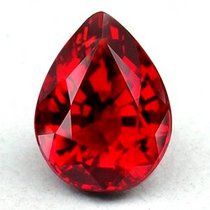 Ruby is the red variety of the Corundum family (All other color variations of Corundum being referred to as a Sapphire). Rubies range from pinkish, purplish, orangey and brownish reds, depending on the chromium and iron content of the stone. In order for corundum to be a "Ruby", it has to have the right tone of color. Most Gemologists expect a medium to medium dark color tone, naming any tone lighter than that, a pink sapphire. Rubies arouse the senses, stir the imagination, and are said to guarantee health, wisdom, wealth and success in love. It is harder than any natural gemstone except diamond, which means a ruby is durable enough for everyday wear. It is the traditional wedding anniversary gift for a couple's 15th and 40th year. To the ancients, ruby was known as "the king of gems". To some it was a representation of the sun. To others it represented integrity, devotion, happiness, healing, courage, romance, generosity, inspiration, and prosperity.
Ruby is the red variety of the Corundum family (All other color variations of Corundum being referred to as a Sapphire). Rubies range from pinkish, purplish, orangey and brownish reds, depending on the chromium and iron content of the stone. In order for corundum to be a "Ruby", it has to have the right tone of color. Most Gemologists expect a medium to medium dark color tone, naming any tone lighter than that, a pink sapphire. Rubies arouse the senses, stir the imagination, and are said to guarantee health, wisdom, wealth and success in love. It is harder than any natural gemstone except diamond, which means a ruby is durable enough for everyday wear. It is the traditional wedding anniversary gift for a couple's 15th and 40th year. To the ancients, ruby was known as "the king of gems". To some it was a representation of the sun. To others it represented integrity, devotion, happiness, healing, courage, romance, generosity, inspiration, and prosperity.August Birthstone: Peridot
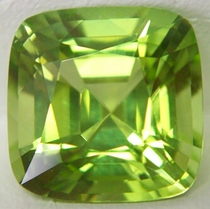 The word Peridot is derived from the Greek word "faridat " which means "gem". The peridot (pronounced pear-a-doe) is a pale green variety of chrysolite and used as the birthstone for August. Peridots are one of the few gemstones that come in only one color. The depth of green depends on how much iron is contained in the crystal structure. Peridots are often referred to as "poor man's emerald". Peridot is said to host magical powers and healing properties to protect against nightmares and to bring the wearer power, influence, and a wonderful year.
The word Peridot is derived from the Greek word "faridat " which means "gem". The peridot (pronounced pear-a-doe) is a pale green variety of chrysolite and used as the birthstone for August. Peridots are one of the few gemstones that come in only one color. The depth of green depends on how much iron is contained in the crystal structure. Peridots are often referred to as "poor man's emerald". Peridot is said to host magical powers and healing properties to protect against nightmares and to bring the wearer power, influence, and a wonderful year.September Birthstone: Sapphire
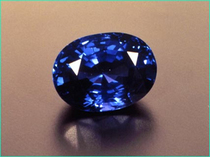 Sapphire, the September birthstone, has been popular since the middle ages and, according to folklore, will protect your loved ones from envy and harm. Sapphires have been worn by royalty throughout the ages as a symbol of good fortune, virtue, wisdom and holiness. Princess Diana and Princess Anne both received sapphire engagement rings and the British Crown Jewels are full of large blue sapphires, the symbol of pure and wise rulers. Sapphire is a variety of the gem species corundum and occurs in all colors of the rainbow. Pink, purple, green, orange, or yellow corundum are known by their color (pink sapphire, green sapphire). Ruby is the red variety of corundum. It is also the traditional wedding anniversary gift for a couple's 5th and 45th year.
Sapphire, the September birthstone, has been popular since the middle ages and, according to folklore, will protect your loved ones from envy and harm. Sapphires have been worn by royalty throughout the ages as a symbol of good fortune, virtue, wisdom and holiness. Princess Diana and Princess Anne both received sapphire engagement rings and the British Crown Jewels are full of large blue sapphires, the symbol of pure and wise rulers. Sapphire is a variety of the gem species corundum and occurs in all colors of the rainbow. Pink, purple, green, orange, or yellow corundum are known by their color (pink sapphire, green sapphire). Ruby is the red variety of corundum. It is also the traditional wedding anniversary gift for a couple's 5th and 45th year.October Birthstones: Opal and Tourmaline
OPAL
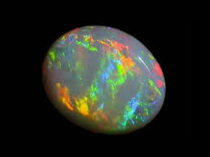 Opal is without doubt one of nature's most remarkable gems. Opal is a chameleon of a thousand colors. It has the essence of every gem combined into one. Opal, October's birthstone, is recognized as one of the most precious gems in the world. The name Opal derives from the Greek Opallos, meaning "to see a change of color." Opals range in color from milky white to black with flashes of yellow, orange, green, red, and blue. An opal's beauty is the product of contrast between its color play and its background. It was only in the 1960's that a team of Australian scientists analyzed opals with an electron microscope and discovered the causes of opal's unique optical properties. It was discovered that small spheres from silica gel caused interference and refraction, which are responsible for the unbelievable play of colors. Most opal is more than 60 million years old. They are extremely unique; no two are exactly a like. Opal is an organic, "living" stone, which means it must be protected from heat and detergents that dry out this gem. It is said that Opals stimulate healing and increase friendship and healthful emotions.
Opal is without doubt one of nature's most remarkable gems. Opal is a chameleon of a thousand colors. It has the essence of every gem combined into one. Opal, October's birthstone, is recognized as one of the most precious gems in the world. The name Opal derives from the Greek Opallos, meaning "to see a change of color." Opals range in color from milky white to black with flashes of yellow, orange, green, red, and blue. An opal's beauty is the product of contrast between its color play and its background. It was only in the 1960's that a team of Australian scientists analyzed opals with an electron microscope and discovered the causes of opal's unique optical properties. It was discovered that small spheres from silica gel caused interference and refraction, which are responsible for the unbelievable play of colors. Most opal is more than 60 million years old. They are extremely unique; no two are exactly a like. Opal is an organic, "living" stone, which means it must be protected from heat and detergents that dry out this gem. It is said that Opals stimulate healing and increase friendship and healthful emotions.
 Opal is without doubt one of nature's most remarkable gems. Opal is a chameleon of a thousand colors. It has the essence of every gem combined into one. Opal, October's birthstone, is recognized as one of the most precious gems in the world. The name Opal derives from the Greek Opallos, meaning "to see a change of color." Opals range in color from milky white to black with flashes of yellow, orange, green, red, and blue. An opal's beauty is the product of contrast between its color play and its background. It was only in the 1960's that a team of Australian scientists analyzed opals with an electron microscope and discovered the causes of opal's unique optical properties. It was discovered that small spheres from silica gel caused interference and refraction, which are responsible for the unbelievable play of colors. Most opal is more than 60 million years old. They are extremely unique; no two are exactly a like. Opal is an organic, "living" stone, which means it must be protected from heat and detergents that dry out this gem. It is said that Opals stimulate healing and increase friendship and healthful emotions.
Opal is without doubt one of nature's most remarkable gems. Opal is a chameleon of a thousand colors. It has the essence of every gem combined into one. Opal, October's birthstone, is recognized as one of the most precious gems in the world. The name Opal derives from the Greek Opallos, meaning "to see a change of color." Opals range in color from milky white to black with flashes of yellow, orange, green, red, and blue. An opal's beauty is the product of contrast between its color play and its background. It was only in the 1960's that a team of Australian scientists analyzed opals with an electron microscope and discovered the causes of opal's unique optical properties. It was discovered that small spheres from silica gel caused interference and refraction, which are responsible for the unbelievable play of colors. Most opal is more than 60 million years old. They are extremely unique; no two are exactly a like. Opal is an organic, "living" stone, which means it must be protected from heat and detergents that dry out this gem. It is said that Opals stimulate healing and increase friendship and healthful emotions.
TOURMALINE
Tourmaline has become a favorite gemstone among jewelry designers, and gem collectors all over the world. Since it is available in a wide variety of colors, it is ideally suited to almost anyone's taste. Tourmaline also is known for displaying several colors in the same gemstone. These bi-color or tri-color gems are formed in many combinations; gemstones with clear color distinctions are highly prized. One multi-color variety is known as watermelon tourmaline, and features green, pink, and white color bands to resemble its namesake. This gemstone has an endless number of faces, and for that reason it suits all moods. No wonder that magical powers have been attributed to it since ancient times. In particular, it is the gemstone of love and of friendship, and is said to render them firm and long-lasting.
Tourmaline has become a favorite gemstone among jewelry designers, and gem collectors all over the world. Since it is available in a wide variety of colors, it is ideally suited to almost anyone's taste. Tourmaline also is known for displaying several colors in the same gemstone. These bi-color or tri-color gems are formed in many combinations; gemstones with clear color distinctions are highly prized. One multi-color variety is known as watermelon tourmaline, and features green, pink, and white color bands to resemble its namesake. This gemstone has an endless number of faces, and for that reason it suits all moods. No wonder that magical powers have been attributed to it since ancient times. In particular, it is the gemstone of love and of friendship, and is said to render them firm and long-lasting.
November Birthstones: Yellow Topaz and Citrine
YELLOW TOPAZ
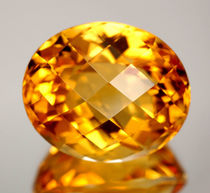 Topaz is a gemstone available in a rich rainbow of colors. Prized for several thousand years in antiquity, all yellow gems in antiquity were called topaz. Most topazes are naturally yellow or brown, and this is the classic November birthstone color. The most prized color of topaz is called Imperial topaz after the Russian Czars of the 1800s and features a magnificent orange body color with pinkish undertones. Topaz was believed to counteract poison and instantly quench the heat of boiling water. All these magical powers were supposed to increase or decrease with changes of the moon.
Topaz is a gemstone available in a rich rainbow of colors. Prized for several thousand years in antiquity, all yellow gems in antiquity were called topaz. Most topazes are naturally yellow or brown, and this is the classic November birthstone color. The most prized color of topaz is called Imperial topaz after the Russian Czars of the 1800s and features a magnificent orange body color with pinkish undertones. Topaz was believed to counteract poison and instantly quench the heat of boiling water. All these magical powers were supposed to increase or decrease with changes of the moon.
 Topaz is a gemstone available in a rich rainbow of colors. Prized for several thousand years in antiquity, all yellow gems in antiquity were called topaz. Most topazes are naturally yellow or brown, and this is the classic November birthstone color. The most prized color of topaz is called Imperial topaz after the Russian Czars of the 1800s and features a magnificent orange body color with pinkish undertones. Topaz was believed to counteract poison and instantly quench the heat of boiling water. All these magical powers were supposed to increase or decrease with changes of the moon.
Topaz is a gemstone available in a rich rainbow of colors. Prized for several thousand years in antiquity, all yellow gems in antiquity were called topaz. Most topazes are naturally yellow or brown, and this is the classic November birthstone color. The most prized color of topaz is called Imperial topaz after the Russian Czars of the 1800s and features a magnificent orange body color with pinkish undertones. Topaz was believed to counteract poison and instantly quench the heat of boiling water. All these magical powers were supposed to increase or decrease with changes of the moon.
CITRINE
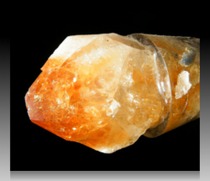 Many people have come to know and love this stone under the name gold topaz, although in actual fact it has very little in common with the higher-quality gemstone topaz. Citrine is a yellow-to-golden member of the quartz mineral group. A deep golden variety from Madiera Spain can resemble the costly imperial topaz gem stone, which is one reason that citrine is a popular birthstone alternative to those born in November. Citrine is known as the "healing quartz". This golden gemstone is said to support vitality and health while encouraging and guiding hope, energy and warmth within the wearer. Citrine can be found in a variety of shades ranging from pastel yellow to dark brownish orange.
Many people have come to know and love this stone under the name gold topaz, although in actual fact it has very little in common with the higher-quality gemstone topaz. Citrine is a yellow-to-golden member of the quartz mineral group. A deep golden variety from Madiera Spain can resemble the costly imperial topaz gem stone, which is one reason that citrine is a popular birthstone alternative to those born in November. Citrine is known as the "healing quartz". This golden gemstone is said to support vitality and health while encouraging and guiding hope, energy and warmth within the wearer. Citrine can be found in a variety of shades ranging from pastel yellow to dark brownish orange.
 Many people have come to know and love this stone under the name gold topaz, although in actual fact it has very little in common with the higher-quality gemstone topaz. Citrine is a yellow-to-golden member of the quartz mineral group. A deep golden variety from Madiera Spain can resemble the costly imperial topaz gem stone, which is one reason that citrine is a popular birthstone alternative to those born in November. Citrine is known as the "healing quartz". This golden gemstone is said to support vitality and health while encouraging and guiding hope, energy and warmth within the wearer. Citrine can be found in a variety of shades ranging from pastel yellow to dark brownish orange.
Many people have come to know and love this stone under the name gold topaz, although in actual fact it has very little in common with the higher-quality gemstone topaz. Citrine is a yellow-to-golden member of the quartz mineral group. A deep golden variety from Madiera Spain can resemble the costly imperial topaz gem stone, which is one reason that citrine is a popular birthstone alternative to those born in November. Citrine is known as the "healing quartz". This golden gemstone is said to support vitality and health while encouraging and guiding hope, energy and warmth within the wearer. Citrine can be found in a variety of shades ranging from pastel yellow to dark brownish orange.December Birthstones: Tanzanite, Blue Topaz and Turquoise
TURQUOISE
 Turquoise is the oldest and most popular of December's birthstones. It was found on artifacts dating back 5000 years, in ancient Egypt, Sumeria and Mesopotamia. Its name means "Turkish Stone" in French because that's where the first deposits of turquoise were first found in the ancient world, before the first mines in Egypt. Turquoise ranges in color from sky blue to green. Very often, to enhance this color, jewelers use a lair of wax coat of the gem which means that the color is not permanent.
Turquoise is the oldest and most popular of December's birthstones. It was found on artifacts dating back 5000 years, in ancient Egypt, Sumeria and Mesopotamia. Its name means "Turkish Stone" in French because that's where the first deposits of turquoise were first found in the ancient world, before the first mines in Egypt. Turquoise ranges in color from sky blue to green. Very often, to enhance this color, jewelers use a lair of wax coat of the gem which means that the color is not permanent.
 Turquoise is the oldest and most popular of December's birthstones. It was found on artifacts dating back 5000 years, in ancient Egypt, Sumeria and Mesopotamia. Its name means "Turkish Stone" in French because that's where the first deposits of turquoise were first found in the ancient world, before the first mines in Egypt. Turquoise ranges in color from sky blue to green. Very often, to enhance this color, jewelers use a lair of wax coat of the gem which means that the color is not permanent.
Turquoise is the oldest and most popular of December's birthstones. It was found on artifacts dating back 5000 years, in ancient Egypt, Sumeria and Mesopotamia. Its name means "Turkish Stone" in French because that's where the first deposits of turquoise were first found in the ancient world, before the first mines in Egypt. Turquoise ranges in color from sky blue to green. Very often, to enhance this color, jewelers use a lair of wax coat of the gem which means that the color is not permanent.
BLUE TOPAZ
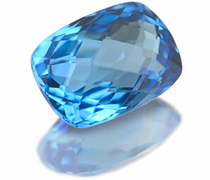 The second of the modern December birthstones is Blue Topaz. Its name comes either from the Sanskrit word "tapas" which means fire, the symbol of love and fidelity, or the Greek word 'topazos' which means "green gemstone". As a precious stone, Topaz became known only in the classical era. In the middle ages, the name topaz was used to name any yellow gemstone. Only later did it receive its proper destination, describing the current stone. In its pure form, Topaz is colorless. However, skilled jewelers can turn it into just about any color with a little treatment, such as green, pink, blue and pink.
The second of the modern December birthstones is Blue Topaz. Its name comes either from the Sanskrit word "tapas" which means fire, the symbol of love and fidelity, or the Greek word 'topazos' which means "green gemstone". As a precious stone, Topaz became known only in the classical era. In the middle ages, the name topaz was used to name any yellow gemstone. Only later did it receive its proper destination, describing the current stone. In its pure form, Topaz is colorless. However, skilled jewelers can turn it into just about any color with a little treatment, such as green, pink, blue and pink.
 The second of the modern December birthstones is Blue Topaz. Its name comes either from the Sanskrit word "tapas" which means fire, the symbol of love and fidelity, or the Greek word 'topazos' which means "green gemstone". As a precious stone, Topaz became known only in the classical era. In the middle ages, the name topaz was used to name any yellow gemstone. Only later did it receive its proper destination, describing the current stone. In its pure form, Topaz is colorless. However, skilled jewelers can turn it into just about any color with a little treatment, such as green, pink, blue and pink.
The second of the modern December birthstones is Blue Topaz. Its name comes either from the Sanskrit word "tapas" which means fire, the symbol of love and fidelity, or the Greek word 'topazos' which means "green gemstone". As a precious stone, Topaz became known only in the classical era. In the middle ages, the name topaz was used to name any yellow gemstone. Only later did it receive its proper destination, describing the current stone. In its pure form, Topaz is colorless. However, skilled jewelers can turn it into just about any color with a little treatment, such as green, pink, blue and pink.
TANZANITE
In 2002, the American Gem Trade Association officially added tanzanite to the modern list of birthstones for the month of December. Discovered in the late 1960s in Tanzania, and found exclusively in this tiny area of the world, tanzanite exhibits a rich violet-blue color for which the gemstone is treasured. Colors range from blue to purple, and tanzanites that are medium dark in tone, vivid in saturation, and slightly violet blue command premium prices.
In 2002, the American Gem Trade Association officially added tanzanite to the modern list of birthstones for the month of December. Discovered in the late 1960s in Tanzania, and found exclusively in this tiny area of the world, tanzanite exhibits a rich violet-blue color for which the gemstone is treasured. Colors range from blue to purple, and tanzanites that are medium dark in tone, vivid in saturation, and slightly violet blue command premium prices.
4075 Linglestown Road #261 , Harrisburg, PA 17112 610-543-0743 Sitemap Copyright © 2007 - 2025 Pennsylvania Jewelers Association. |
